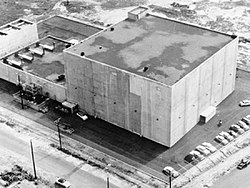
Back Semi Automatic Ground Environment Catalan Semi-Automatic Ground Environment German Semi Automatic Ground Environment Spanish Semi-Automatic Ground Environment Finnish Semi-Automatic Ground Environment French SAGE Croatian Semi Automatic Ground Environment Italian 半自動式防空管制組織 Japanese 반자동식 방공조직 Korean SAGE Polish
| Semi-Automatic Ground Environment | |
|---|---|
 | |
| General information | |
| Type | military C3 human–computer interface |
| Country | United States |
| Opened | 1958 June 26 — DC-01 1958 December 1 — DC-03 1959 (early) — CC-01 1966 April 1 — CC-05 |
| Design and construction | |
| Architect(s) | USAF Air Materiel Command Western Electric[4] System Development Corporation[4] Burroughs Corporation |
The Semi-Automatic Ground Environment (SAGE) was a system of large computers and associated networking equipment that coordinated data from many radar sites and processed it to produce a single unified image of the airspace over a wide area.[5] SAGE directed and controlled the NORAD response to a possible Soviet air attack, operating in this role from the late 1950s into the 1980s. Its enormous computers and huge displays remain a part of Cold War lore, and after decommissioning were common props in movies such as Dr. Strangelove and Colossus, and on science fiction TV series such as The Time Tunnel.
The processing power behind SAGE was supplied by the largest discrete component-based computer ever built, the AN/FSQ-7, manufactured by IBM. Each SAGE Direction Center (DC) housed an FSQ-7 which occupied an entire floor, approximately 22,000 square feet (2,000 m2) not including supporting equipment. The FSQ-7 was actually two computers, "A" side and "B" side. Computer processing was switched from "A" side to "B" side on a regular basis, allowing maintenance on the unused side. Information was fed to the DCs from a network of radar stations as well as readiness information from various defense sites. The computers, based on the raw radar data, developed "tracks" for the reported targets, and automatically calculated which defenses were within range. Operators used light guns to select targets on-screen for further information, select one of the available defenses, and issue commands to attack. These commands would then be automatically sent to the defense site via teleprinter.
Connecting the various sites was an enormous network of telephones, modems and teleprinters. Later additions to the system allowed SAGE's tracking data to be sent directly to CIM-10 Bomarc missiles and some of the US Air Force's interceptor aircraft in-flight, directly updating their autopilots to maintain an intercept course without operator intervention. Each DC also forwarded data to a Combat Center (CC) for "supervision of the several sectors within the division"[6] ("each combat center [had] the capability to coordinate defense for the whole nation").[7]: 51
SAGE became operational in the late 1950s and early 1960s at a combined cost of billions of dollars. It was noted that the deployment cost more than the Manhattan Project—which it was, in a way, defending against. Throughout its development, there were continual concerns about its real ability to deal with large attacks, and the Operation Sky Shield tests showed that only about one-fourth of enemy bombers would have been intercepted.[8] Nevertheless, SAGE was the backbone of NORAD's air defense system into the 1980s, by which time the tube-based FSQ-7s were increasingly costly to maintain and completely outdated. Today the same command and control task is carried out by microcomputers, based on the same basic underlying data.
- ^ The SAGE Blockhouse - Future Home of the Cold War / Peace Museum Archived 2013-05-11 at the Wayback Machine. Coldwarpeacemuseum.org. Retrieved on 2013-09-18.
- ^ Cite error: The named reference
Schaffelwas invoked but never defined (see the help page). - ^ Cite error: The named reference
EdwardsBenjwas invoked but never defined (see the help page). - ^ a b Cite error: The named reference
IYDwas invoked but never defined (see the help page). - ^ Wragg, David W. (1973). A Dictionary of Aviation (first ed.). Osprey. p. 232. ISBN 9780850451634.
- ^ Cite error: The named reference
Introwas invoked but never defined (see the help page). - ^ Cite error: The named reference
Winklerwas invoked but never defined (see the help page). - ^ Mola, Roger A. (March 2002). "This Is Only a Test". Air & Space Magazine. Retrieved 26 July 2017.